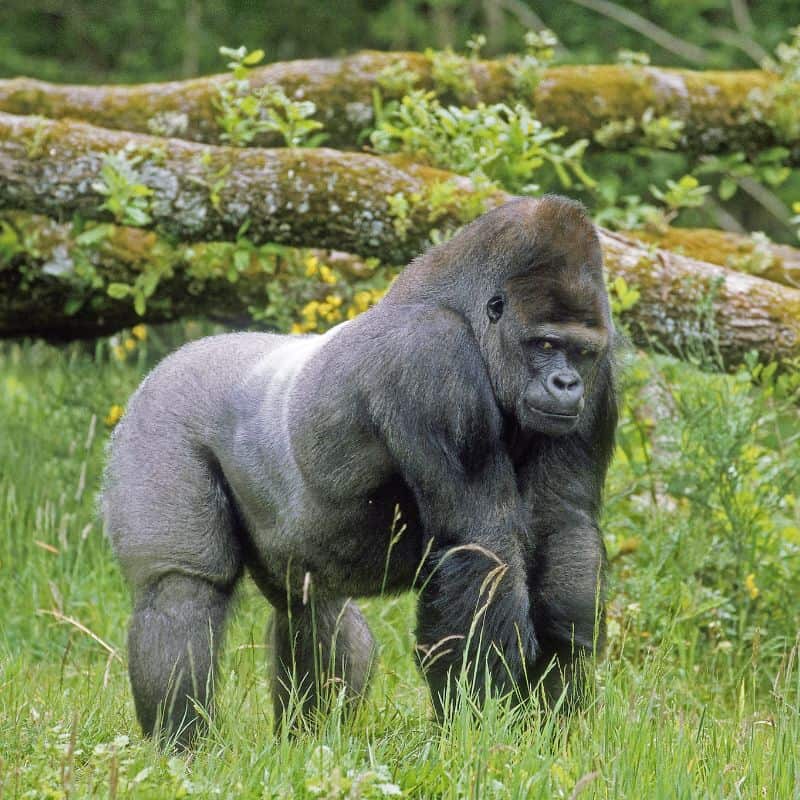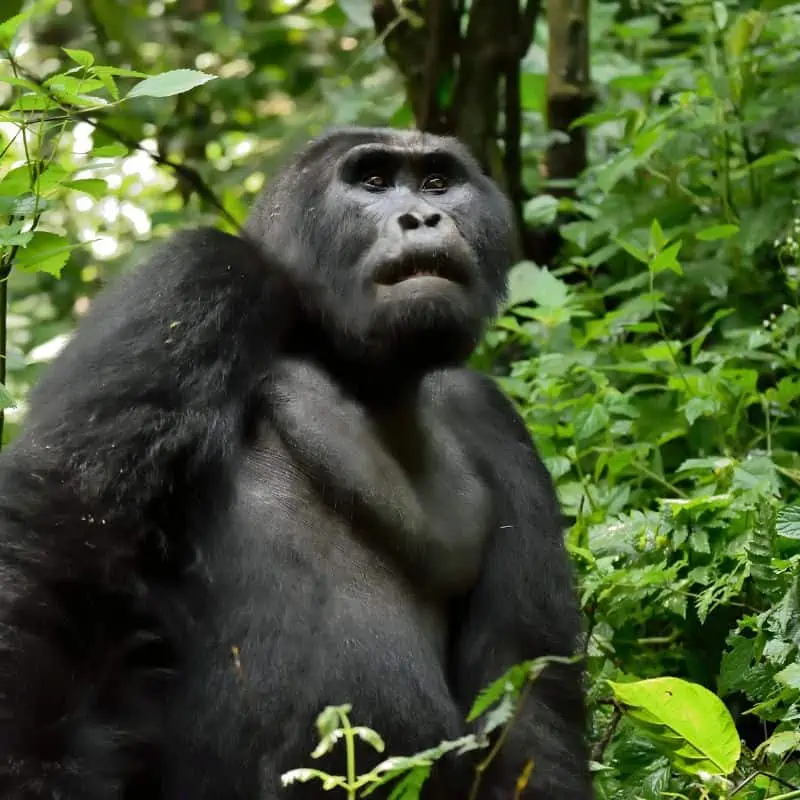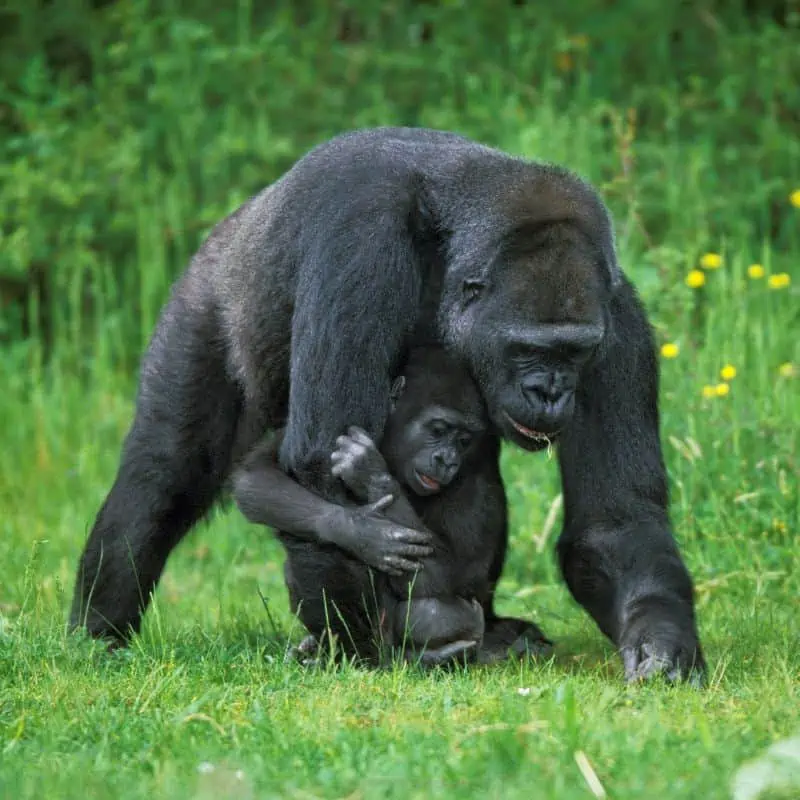There are different types of gorillas, each with a unique set of characteristics. This article will explore the different types of gorillas and what makes them unique.
There are two gorilla species, the Eastern and Western ones. Each of these species has two subspecies. The Eastern gorilla is divided into Eastern Lowland (Grauer’s) and Mountain gorillas, while the Western gorilla is divided into the Western Lowland and the Cross River gorilla. This means we have four different types of gorillas in total.
Sadly, all gorilla species are considered endangered. All gorilla species are found in tropical rainforests in Africa and are the biggest apes in the genus of primates.
Eastern Gorilla (Gorilla beringei)

The Eastern gorilla (Gorilla beringei) is the largest living primate (the King Kong of gorillas), with males tipping the scale around 300 to 485 lb and standing up to 6.4 ft tall. Females weigh between 200 to 220 lb and can reach 4.9 ft in length.
These gorillas are typically found in a stable family group (one alpha male leader, many females, and all offspring.)
The Eastern gorilla has a huge frame, including a big head, a broad chest, and long limbs, with black fur covering its body.
When the male Eastern gorilla becomes an adult, the hare on their backs turns white (silvery “saddle”), similar to grey-haired elderly humans, and that’s where the name “silverbacks” comes from.
These primates are born with massive noses with big nostrils and are bald in the face, breast, hands, and feet.
You will find the Eastern gorilla on the high slopes of mountain rainforests in Uganda, Rwanda, the Democratic Republic of the Congo (DRC), and in the forests of the Albertine Rift located in the eastern part of the DRC.
The International Union for Conservation of Nature (IUCN) assessed the Eastern gorilla on August 02, 2018, and classified the specie as critically endangered, providing the following details:
- The population has 2,600 mature individuals, and it’s continuously decreasing.
- Gorillas in the DRC are at risk due to a breakdown in law and order, combined with poverty and economic insecurity, and armed forces in the field restrict the efforts of conservation groups.
Eastern Lowland Gorilla

The Eastern Lowland gorilla, commonly referred to as Grauer’s gorillas (Gorilla beringei graueri), is a subspecies of the Eastern gorilla. Males weigh between 330 to 460 lb, standing 5.5 to 6.4 ft tall. Females weigh 168 to 200 lb with an average length of 4 to 5.2 ft.
The Eastern Lowland gorilla is a peaceful and social primate that congregates in groups of two to more than 30. One dominant silverback male, many females, and the young make up a typical group.
Each group of silverbacks has a dominant alpha male, and together they protect the group.
When young silverback males attain sexual maturity, they begin to gradually separate from their natal group and seek for females to start their own troop.
The diet of an Eastern Lowland gorilla consists mostly of plants, although it also includes insects like ants and termites.
Fruits, leaves, stems, and bark are common plant foods for these primates. Eastern Lowland gorillas, who live in low-lying tropical woods, are less nomadic and eat more herbaceous plants than their western counterparts.
These primates live in the mountainous forests of the Democratic Republic of Congo (DRC), Kahuzi-Biega National Parks, Maiko National Park, and Usala Forest. Poaching, civil turmoil, and the degradation of gorilla habitat by logging, mining, and agriculture are all factors that threaten the survival of the Eastern Lowland gorilla.
In the mid-1990s, the eastern lowland gorilla population was estimated to be about 17,000. Since then, researchers have seen a steep drop, with the number being estimated to be below 5,000. The instability in the area has made it hard to keep track of the animals for a very long time.
The IUCN placed the Eastern Lowland gorilla on its red list when it conducted an assessment study on March 1, 2016. The conclusion of the assessment made for grim reading as the Grauer’s gorillas were deemed critically endangered. An assessment that still rings true today.
Mountain Gorilla

The Mountain gorilla (Gorilla beringei beringei), also known as the Congo Mountain Gorilla, is the other subspecies of the Eastern gorilla.
Males weigh between 265 to 485 lb standing 4 to 6 ft. tall. Females weigh between 150 to 250 lb and reach standing heights of 5 ft.
Mountain gorillas, as the name indicates, live in forests found high up mountains between 8,000 and 13,000 feet in height.
Compared to the other great apes, they have more and thicker fur. The fur is an essential survival tool for their environment, where temperatures often dip below freezing.
More than half of this gorilla population is concentrated in the Virunga Mountains, a chain of dormant volcanoes that divides the Democratic Republic of the Congo, Rwanda, and Uganda borders.
Bwindi Impenetrable National Park, located in Uganda, is home to the remaining population.
These large apes have been seen to consume as much as 40 pounds of plant matter daily. They seldom need to drink since their diet, which consists mostly of celery, thistles, roots, and wood, is so succulent that it contains a significant amount of water and water dew.
Extremely friendly, these apes congregate in groups of two to forty, with one male serving as the group’s silverback and de facto head of security. About 11 years of age, most males begin to move away from their biological communities.
Once assumed to be extinct at the turn of the century, the mountain gorilla subspecies was discovered in 1902. Since then, its population has faced years of conflict, poaching, habitat loss, and sickness.
The ICUN conducted an assessment on the Mountain gorilla on July 31, 2020, and placed them on the red list deeming the specie to be endangered.
The number of mature gorillas was estimated at 600, and the population was on the increase. The WWF has confirmed the number is over 1,000 now.
Western Gorilla (Gorilla gorilla)

The Western gorilla (Gorilla gorilla) is one of two species that make up the genus gorilla and the most abundant gorilla found today. Males weigh an average of 370 lb, standing 4 to 6 ft. Tall. Females weigh between 130 to 180 lb and can reach a height of 4 to 5 ft.
The Western gorilla is lighter in color (brown to grey) than the Eastern gorilla and features a short muzzle with a prominent brow ridge and a brownish forehead paired with large jaw muscles and huge teeth.
These primates live in the lowland wetlands, secondary forests, and tropical forests of West Central Africa.
Western gorillas engage in polygyny, where one dominant male mates with all the females in the group, maintaining a constant breeding cycle.
Pregnancy typically lasts between 251 and 289 days. Sexual maturity in male gorillas occurs between the ages of 8 and 9, whereas in females, it happens between the ages of 7 and 8.
Commonly, these creatures are quiet, mild-mannered, and reserved. However, they make terrifying growling noises when threatened or assaulted and become exceedingly lethal. A male Western gorilla will stand erect and pound its chest with its fists to display power or frighten away any threats.
The IUCN has the Western gorilla on its red list after assessing the species on April 1, 2016. The assessment concluded that the Western gorilla is a critically endangered species with a decreasing population. Poaching, loss of habitat, and civil unrest are major threats to its survival.
Western gorillas in safe havens’ greatest danger presently are the Ebola virus, which has killed 33% of the population.
Western Lowland Gorilla

The Western Lowland gorilla (Gorilla gorilla gorilla) is a subspecies of the Western gorilla and is considered the smallest of all the gorilla subspecies. On average, males weigh 310 lb, standing 5 to 6 ft. tall. Females have an average weight of 200 lb and stand 4 to 5 ft. tall.
The Western lowland gorilla is distinct from other gorilla subspecies due to its smaller stature, brown-grey fur, and reddish chest.
Their ears are smaller, and their skulls are broader compared to other types of gorillas. Elderly males with grey hair on their backs and rump are referred to as silverbacks.
Geographically, the Western Lowland gorilla can be found in Angola, the Republic of the Congo, the Central African Republic, Equatorial Guinea, Gabon, Cameroon, and the Democratic Republic of the Congo in lowland wetlands and primary and secondary forests.
Dzanga-Sangha in the Central African Republic is one of the few sites on Earth where people may view western lowland gorillas in their natural habitat.
It takes three years or more of meticulous and patient gorilla monitoring and tracking to acclimatize the primates to the presence of people, which is why chances for gorilla observation are so uncommon.
The IUCN has the Western Lowland gorilla on its red list after assessing them on January 29, 2016, labeling them as critically endangered, noting that only 20-30% of the remaining population resides in protective areas.
Poaching and sickness (Ebola virus) have contributed to a 60% drop in gorilla populations over the last 25 years. Scientists estimate that the western lowland gorilla population would need around 75 years to recover if all risks were eliminated.
Cross River Gorilla

The Cross River gorilla (Gorilla gorilla diehli) is a subspecies of the Western gorilla and is the most endangered type of gorilla, with population numbers as little as 300. Males, on average, weigh between 330 to 440 lb, standing 5 to 6 ft. tall. Females, on average, weigh 220 lb with an average height of 4.7 to 5 ft.
Skull and tooth size are the most obvious ways this subspecies can be distinguished from the more common Western Lowland gorilla, as both subspecies look similar. However, male measurements imply that these gorillas have shorter hands and feet and a higher opposability index when compared with Western Lowland gorillas.
The lowland forests and rainforests of Nigeria and Cameroon (area of 3,000 sq. miles) are home to at least eleven separate populations of Cross River gorillas.
Humans have made their way into the habitat of the Cross River gorilla by cutting down trees for lumber and clearing land areas for farming and livestock.
The IUCN has the Cross River gorilla on its red list after assessing the specie on January 05, 2016, labeling them critically endangered. With only 100 to 250 mature individuals remaining in a declining population, the future of the Cross River gorilla is in danger of becoming extinct.
Cameroon and Nigeria have laws prohibiting the killing of gorillas, but wildlife regulations are seldom enforced, and poaching is rampant even in protected regions.
Final thoughts on different types of gorillas
There are four different types of gorillas, all of which are critically endangered. The Western Lowland gorilla is the most common and can be found in some countries in central Africa.
The Cross River gorilla is the most endangered, with only a few hundred remaining in the wild. Poaching and habitat loss are the biggest threats to all types of gorillas.
With proper conservation efforts, these magnificent creatures may be saved from extinction.
